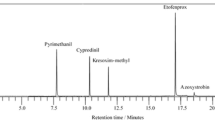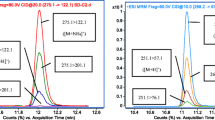Abstract
This work describes the fundamental ability of a commercial ELISA to determine acetamiprid and the application of the ELISA to residue analysis in fruit and vegetable samples. The ELISA exhibited satisfactory sensitivity (I 50 0.6 ng/g; limit of detection 0.053 ng/g) and a high selectivity for acetamiprid versus other neonicotinoid analogs (thiacloprid amide). Methanol, which influenced the sensitivity of the ELISA the least, was selected as the extractant for the ELISA analysis. Simple dilution of sample extracts with water eliminated matrix interferences. Average recoveries from the acetamiprid-spiked agricultural samples were >95% using a simple extraction method. Analytical results obtained from the ELISA were comparable to those obtained from the reference HPLC method (r>0.99). The ELISA applied to the residue analysis of acetamiprid in agricultural products is a rapid, simple, and cost-effective method, and could be successfully applied to the detection of acetamiprid before the distribution of produce.





Similar content being viewed by others
References
Tomlin CDS (ed) (2000) The pesticide manual, 12th edn. The British Crop Protection Council, Farnham, UK, p 9
“Kongetsu No Nogyo” Henshushitsu (ed) (1998) In: Noyaku Toroku Horyu Kijun Handbook, 3rd edn. Chemical Daily Co., Tokyo, Japan, p 26–28 (in Japanese)
US EPA (2005) Code of Federal Regulations (CFR), 40, Part 180, July 1. US Environmental Protection Agency, Washington, DC
Akiyama Y, Yoshioka N, Tsuji M (2002) J AOAC Int 85:692–703
Ueji M, Kobayashi H, Nakamura K (eds) (2002) Analytical methods of pesticide residues. Soft Science, Tokyo, Japan, p 25–27 (in Japanese)
Obana H, Okihashi M, Akutsu K, Kitagawa Y, Hori S (2003) J Agric Food Chem 51:2501–2505
Tokieda M, Ozawa M, Kobayashi S, Gomyo T (1997) J Pestic Sci 22:77–83
Mateu-Sánchez M, Moreno M, Arrebola FJ, Vidal JLM (2003) Anal Sci 19:701–704
Hennion M-C, Barcelo D (1998) Anal Chim Acta 362:3–34
Nunes GS, Toscano IA, Barceló D (1998) Trends Anal Chem 17:79–87
Watanabe S, Ito S, Kamata Y, Omoda N, Yamazaki T, Munakata H, Kaneko T, Yuasa Y (2001) Anal Chim Acta 427:211–219
Watanabe E, Eun H, Baba K, Arao T, Ishii Y, Endo S, Ueji M (2004) J Agric Food Chem 52:2756–2762
Midgley AR, Niswender GD, Rebar RW (1969) Acta Endocrinol 63:163–179
Acknowledgements
This work was funded by the Research Project for Utilizing Advanced Technologies in Agriculture, Forestry and Fisheries. We sincerely express our gratitude to Dr. Yasuo Ishii (The Japan Association for Advancement of Phyto-Regulators, Ibaraki, Japan) for his profitable suggestions.
Author information
Authors and Affiliations
Corresponding author
Rights and permissions
About this article
Cite this article
Watanabe, E., Miyake, S., Baba, K. et al. Immunoassay for acetamiprid detection: application to residue analysis and comparison with liquid chromatography. Anal Bioanal Chem 386, 1441–1448 (2006). https://doi.org/10.1007/s00216-006-0683-z
Received:
Revised:
Accepted:
Published:
Issue Date:
DOI: https://doi.org/10.1007/s00216-006-0683-z




